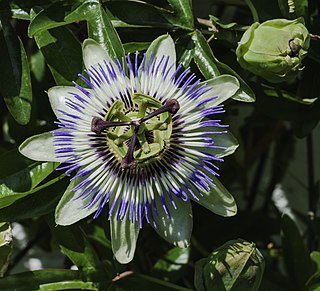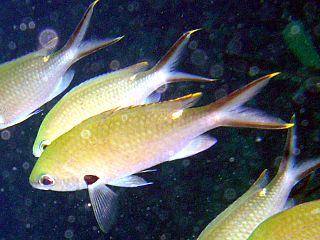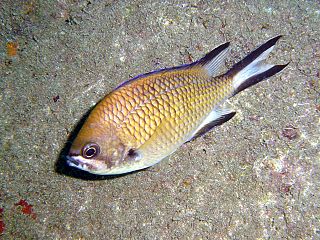
Pomacentridae is a family of ray-finned fish, comprising the damselfishes and clownfishes. This family were formerly placed in the order Perciformes but are now regarded as being incertae sedis in the subseries Ovalentaria in the clade Percomorpha. They are primarily marine, while a few species inhabit freshwater and brackish environments. They are noted for their hardy constitutions and territoriality. Many are brightly colored, so they are popular in aquaria.

Passiflora caerulea, the blue passionflower, bluecrown passionflower or common passion flower, is a species of flowering plant native to South America. It has been introduced elsewhere. It is a vigorous, deciduous or semi-evergreen tendril vine growing to 10 m (33 ft) or more. Its leaves are palmate and fragrant, flowers blue-white with a prominent fringe of coronal filaments in bands of blue, white, and brown. The ovoid orange fruit, growing to 6 cm (2 in), is edible but bland.

Molinia caerulea, known by the common name purple moor-grass, is a species of grass that is native to Europe, west Asia, and north Africa. It grows in locations from the lowlands up to 2,300 m (7,546 ft) in the Alps. Like most grasses, it grows best in acid soils, ideally pH values of between 3.5 and 5, however, it can continue to live under more extreme conditions, sometimes to as low as 2. It is common on moist heathland, bogs and moorland throughout Britain and Ireland. Introduced populations exist in northeastern and northwestern North America.

The Australian green tree frog, also known as simply green tree frog in Australia, White's tree frog, or dumpy tree frog, is a species of tree frog native to Australia and New Guinea, with introduced populations in the United States and New Zealand, though the latter is believed to have died out. It is morphologically similar to some other members of its genus, particularly the magnificent tree frog (R. splendida) and the white-lipped tree frog (R. infrafrenata).

The New Zealand demoiselle, Chromis dispilus, is a damselfish of the genus Chromis, found between North Cape and East Cape of the North Island of New Zealand to depths of about 60 metres, off rocky coasts. Its length is between 15 and 20 cm. Males are highly territorial as they defend their nesting area from other males and other species. These aggressive fish defend their eggs laid by their female counterpart. Spawning occurs between the months of December and March. The New Zealand demoiselle's territory and nesting grounds of this fish are usually the largest in a medium population density. Like most territorial fish they tend to spawn more in higher densities of the same species compared to lower densities. Aggression levels tend to be higher amount higher densities of the same species and lower levels in smaller densities. Aggression also tends to be higher during spawning then during egg defending. Elevated plasma levels of androgen testosterone and 11-Ketotesterone are associated with the heighten levels of aggression shown by the males.

Chromis is a genus of fish in the family Pomacentridae. While the term damselfish describes a group of marine fish including more than one genus, most damselfish are in the genus Chromis. These fish are popular aquarium pets due to their small size, tolerance for poor water quality, and bright colors, though their lifespans tend to be shorter than other fish.

The black-axil chromis, also known as the blackfin chromis or blue-green puller, is a damselfish from the tropical Indo-Pacific. This fish can reach almost 12 centimetres (4.7 in) in length. It inhabits lagoons and reefs after settlement in the late-larval stage, and often occurs in large numbers, feeding above Acropora corals. This fish mostly feeds upon copepods, amphipods, and zoea.

Chromis viridis is a species of damselfish. Individuals tend to be iridescent apple-green and light blue, and reach a maximal length of 10 cm.

Chromis cyanea is a damselfish in the subfamily Pomacentrinae, found in Bermuda, southern Florida and the Caribbean Sea.

Chromis chromis, the damselfish or Mediterranean chromis is a small species of ray-finned fish of the family Pomacentridae from the Eastern Atlantic and Mediterranean.

The spiny chromis is a species of damselfish from the western Pacific. It is the only member of its genus.
Chromis brevirostris, or colloquially known as the shortsnout chromis, is a type of damselfish that was described in 2008 by R. Pyle, J. Earle, and B. Greene in the western Pacific Ocean. This species comes from the genus Chromis which contains eighty species and counting, including C. abyssus, C. circumaurea, C. degruyi, and C. earina. Chromis brevirostris can be found in the Pacific Ocean, located as far north as the Marshall Islands to as far south as Fiji and Vanuatu, and spanning from Palau to Paluwat of the Caroline Islands. The species’ name, Chromis brevirostris, derives from Latin origin; brevis and rostrum mean “short” and “snout” respectively. It is generally abundant in its environment, living at depths of 90–120 metres (300–390 ft), tending to live in groups ranging in size from six to several dozen.

ZooBank is an open access website intended to be the official International Commission on Zoological Nomenclature (ICZN) registry of zoological nomenclature. Any nomenclatural acts need to be registered with ZooBank to be "officially" recognized by the ICZN Code of Nomenclature.

Chromis margaritifer, known commonly as the bicolor chromis, is a species of marine fish in the family Pomacentridae.

Chromis multilineata is a species of fish in the family Pomacentridae. It is commonly known as the brown chromis. It is found in the western Atlantic Ocean from the southern United States south to Brazil and in the eastern Atlantic off St Helena and Ascension Island

The Barrier Reef chromis, also known as the yellowback puller or shining puller, is a species of damselfish in the family Pomacentridae native to the east coast of Australia. It is a small fish with a yellowish-brown dorsal surface separated by a dark stripe from its silvery flanks and underside.

Lighthouse Reef is an atoll in the Caribbean Sea, the easternmost part of the Belize Barrier Reef and one of its three atolls, the other two being Turneffe Atoll and Glover's Reef. Lighthouse Reef is located about 80 kilometres (50 mi) southeast of Belize City. The atoll is of oblong shape, approximately 35 kilometres (22 mi) long from north to south, and about 8 kilometres (5.0 mi) wide. It forms a shallow sandy lagoon with an area of 120 square kilometres (46 sq mi) and a depth between 2 to 6 metres deep.

The Azores chromis or Atlantic chromis is a species of damselfish from the family Pomacentridae which is found in the Macaronesian Islands of the temperate eastern Atlantic Ocean and has been reported from coastal regions of western Africa.

Chromis cinerascens, the green puller, is a diurnal species of damselfish belonging to the genus Chromis. It can be found in the Indo-West Pacific region, in Sri Lanka, Maldives, the Andaman Sea, Malaysia, Indonesia, Vietnam, the Philippines, East Timor, Brunei Darussalam, North-western Australia, Hong Kong and Taiwan. It inhabits coral reefs. It is oviparous, and the males of the species guard and aerate the eggs.

Chromis delta, the deep reef chromis, is a diurnal species of damselfish belonging to the genus Chromis. It can be found in the Indo-West Pacific, from Maldives and Christmas Island to Fiji, north to Taiwan and the Philippines, and south to Vanuatu. It can also be found in Tonga. It inhabits steep outer reef slopes with rich coral growth. They can either appear singly or in small groups remaining near shelter, often at the entrance of large caves or near its ceiling. It is oviparous, and the males of the species guard and aerate the eggs.


















